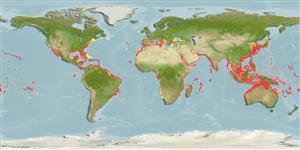>
Carangiformes (Jacks) >
Carangidae (Jacks and pompanos) > Naucratinae
Etymology: Seriola: Latin word diminutive with the meaning of a large earthenware pot (Ref. 45335).
Eponymy: Dr André Marie Constant Duméril (1774–1860) was a French zoologist who qualified as a physician (1793). [...] (Ref. 128868), visit book page.
More on author: Risso.
Environment: milieu / climate zone / depth range / distribution range
Ecologie
marien rifbewoner; oceanodroom (Ref. 51243); diepte 1 - 385 m (Ref. 11441), usually 18 - 72 m (Ref. 9626). Subtropical; 49°N - 36°S, 98°W - 128°E
Circumglobal. Tropical and warm temperate seas. Indo-West Pacific: South Africa, Persian Gulf, southern Japan and the Hawaiian Islands, south to New Caledonia; Mariana and Caroline islands in Micronesia. Western Atlantic: Bermuda (Ref. 26938), Nova Scotia, Canada to Brazil; also from the Gulf of Mexico and the Caribbean Sea (Ref. 9626). Eastern Atlantic: British coast (vagrant) to Morocco and the Mediterranean. Distribution in eastern central Atlantic along the African coast is not well established due to past confusion with Seriola carpenteri (Ref. 7097).
Lengte bij maturiteit / Grootte / Gewicht / Leeftijd
Maturity: Lm 90.8, range 80 - 127 cm
Max length : 190 cm TL mannelijk / geslacht onbekend; (Ref. 3397); common length : 100.0 cm TL mannelijk / geslacht onbekend; (Ref. 3197); max. gepubliceerd gewicht: 80.6 kg (Ref. 3287); max. gerapporteerde leeftijd: 15 Jaren (Ref. 113943)
Dorsale stekels (totaal) : 8; Dorsale zachte stralen (totaal) : 29 - 35; Anale stekels: 3; Anale zachte stralen: 18 - 22. Bluish grey or olivaceous above, silvery white below; amber stripe along midside of body; fins dusky (Ref. 3197). Second dorsal and anal fins with low anterior lobe (Ref. 26938). Species of Seriola lack scutes (Ref. 37816).
Adults found in deep seaward reefs; occasionally entering coastal bays. They feed primarily on fishes such as the bigeye scad, also on invertebrates (Ref. 4233). Small juveniles associate with floating plants or debris in oceanic and offshore waters. Juveniles form small schools or solitary (Ref. 5213). Eggs are pelagic (Ref. 4233). Utilized fresh and frozen; eaten pan-fried, broiled and baked (Ref. 9987). Reported to cause ciguatera in some areas (Ref. 26938).
Spawning happens during the summer, in areas near the coast. Embryo development lasts about 40 hours at 23° and larval development 31-36 days. Egg size 1.9 mm, larval at hatching 2.9 mm.
Paxton, J.R., D.F. Hoese, G.R. Allen and J.E. Hanley, 1989. Pisces. Petromyzontidae to Carangidae. Zoological Catalogue of Australia, Vol. 7. Australian Government Publishing Service, Canberra, 665 p. (Ref. 7300)
Status op de Rode Lijst van het IUCN (Ref. 130435: Version 2024-2)
Gevaar voor de mens
Reports of ciguatera poisoning
Gebruik door de mens
Visserij: van minder commercieel belang; Aquacultuur: commercieel; sportvis: ja; Aquarium: Publieke aquaria
Tools
Speciale rapporten
Download XML
Internetbronnen
Estimates based on models
Preferred temperature (Ref.
123201): 16.9 - 29, mean 27.1 °C (based on 3486 cells).
Fylogenetische diversiteitsindex (Ref.
82804): PD
50 = 0.5020 [Uniqueness, from 0.5 = low to 2.0 = high].
Bayesian length-weight: a=0.01778 (0.01360 - 0.02326), b=2.91 (2.83 - 2.99), in cm total length, based on LWR estimates for this species (Ref.
93245).
Trofisch niveau (Ref.
69278): 4.5 ±0.0 se; based on diet studies.
Generation time: 5.5 (3.9 - 5.8) years. Estimated as median ln(3)/K based on 11
growth studies.
Weerstandsvermogen (Ref.
120179): Gemiddeld, minimale populatieverdubbelingstijd 1,4-4,4 jaar (K=0.18; tm=4; tmax=15).
Prior r = 0.48, 95% CL = 0.32 - 0.72, Based on 1 full stock assessment.
Fishing Vulnerability (Ref.
59153): Moderate to high vulnerability (54 of 100).
Climate Vulnerability (Ref.
125649): High vulnerability (62 of 100).
Nutrients (Ref.
124155): Calcium = 15 [7, 27] mg/100g; Iron = 0.641 [0.347, 1.180] mg/100g; Protein = 19.9 [16.9, 22.6] %; Omega3 = 0.238 [0.141, 0.418] g/100g; Selenium = 31.8 [16.4, 60.8] μg/100g; VitaminA = 62.5 [8.3, 430.9] μg/100g; Zinc = 0.351 [0.235, 0.528] mg/100g (wet weight); based on
nutrient studies.
